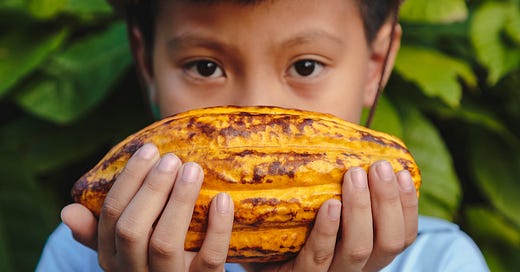Chocolate. For many of us, even thinking about the creamy, delicious goodness conjures up the idea of mouth-watering, satisflying taste and aroma. Chocolate comes in so many forms and pairs so well with so many different foods and beverages. According to science, it not only tastes great, but it can actually make you happier. Chocolate contains tryptophan which the brain uses to produce serotonin which brings on feelings of satisfaction and joy. I’m not a huge chocoholic, but during a certain time of year, those Cadbury mini eggs always seem to find their way into my shopping cart.
Photo Credit: aduna.com
For the sake of education, here are just a few facts about where chocolate comes from and what it takes to make it available as that delicious confection we enjoy. Chocolate is made from cacao beans which come from the Theobroma cacao tree. The tree grows in tropical climates throughout the world. Ghana and the Ivory Coast of West Africa provide 70% of the world’s cacao. The cacao tree produces flower pods which, when harvested, are cut open to remove the 30-50 beans and pulp each pod produces. Fermentation begins immediately and farmers allow this process for about a week. This process kills bacteria and enhances flavor. The beans are then dried, bagged and shipped off for roasting. The shells are separated off and the beans are then ground. Chocolate makers add sugar, milk, cocoa butter and vanilla during the grinding process. From there, the chocolate is tempered by raising and lowering the temperature to create a smooth and firm product. The last step is to put the chocolate in molds and wrap it for shipping. Chocolate doesn’t just grow on trees! There’s a lot of work involved to make chocolate desirable to the general public.
Photo credit: Confectionary Production
Sadly, there’s a downside to the world’s demand for chocolate. All the work mentioned above requires a lot of hands-on labor. In the past few decades, a handful of organizations and journalists have exposed the widespread use of child labor, and in many cases slavery, on cocoa farms in Western Africa and South America. Over the years, the chocolate industry has become increasingly secretive, making it difficult for reporters to access where human rights violations are occurring and to get this information to the public. These cocoa farms supply product to all the big name chocolate companies: Hershey’s, Mars, Cadbury and Nestle. Most cocoa farmers earn less than $1 per day, far below the extreme poverty line. As a result they often resort to child labor to keep their prices competitive. Children are sold to traffickers or farm owners by their own relatives who are unaware of the dangerous work environments and lack of daily provisions or education. Many of these children, who can be as young as age five, work up to 14 hours per day. Often if they don’t work fast enough, they are beaten or deprived of food.
Photo Credit: cacultured.com
The good news is that some chocolate makers are looking to change the industry and eliminate the demand for child labor all while providing a product that maintains a quality standard for their customers. Tony’s Chocolonely, a Dutch chocolate manufacturer, is attempting to tackle the problems of poverty in countries that grow cacao which result in deforestation and trafficking of children. Another small company, 57 Chocolate, was started by two sisters originally from Ghana whose love for the people of their country prompted them to try to change the systems in Ghana that contribute to the ugly side of the industry. CBS Sunday Morning produced an expose about these business owners whose goal is to change the status quo and make chocolate a respectable commodity. Their story prompted me to look more deeply into what it means when we purchase all that Halloween candy.
Photo credit: tonyschocolonely.com
In light of what we now know, here are some questions to ask ourselves. Is our love of chocolate worth paying a little more to support ethical companies who are attempting to buck the big name chocolate sellers to clean up the industry? Does it matter enough to us that children are being exploited to feed our craving? Am I willing to give up my beloved chocolate mini eggs until the huge, profit-making company is willing to own up to its unproven claims that they are not associated with child labor and still pay their cocoa farmers only $2 per day? Can we turn a blind eye when we see those appealing packages in our grocery stores? Tune in and follow your heart. For me, all I need to do is picture the children on those brutal cacao farms to have a diminished appetite for a Snickers bar.
I’m including the link to the CBS Sunday Morning story as well as links to Tony’s Chocolonely and 57 Chocolate. Tony’s has a limited number of products available on Amazon or you can visit these websites. I’ve also posted a link to a documentary called “The Dark Side of Chocolate” that explains more about the exploitation of children in the industry.







Thank you for sharing this expose of the Chocolate makers and their desire for profits above caring what happens to these children. Also thank you for the research you put into this and all your blogs like it.
Timely with Halloween 🎃 upon us. That is so sad to hear. What many people enjoy as a treat is actually a nightmare for many. Thank you for sharing.